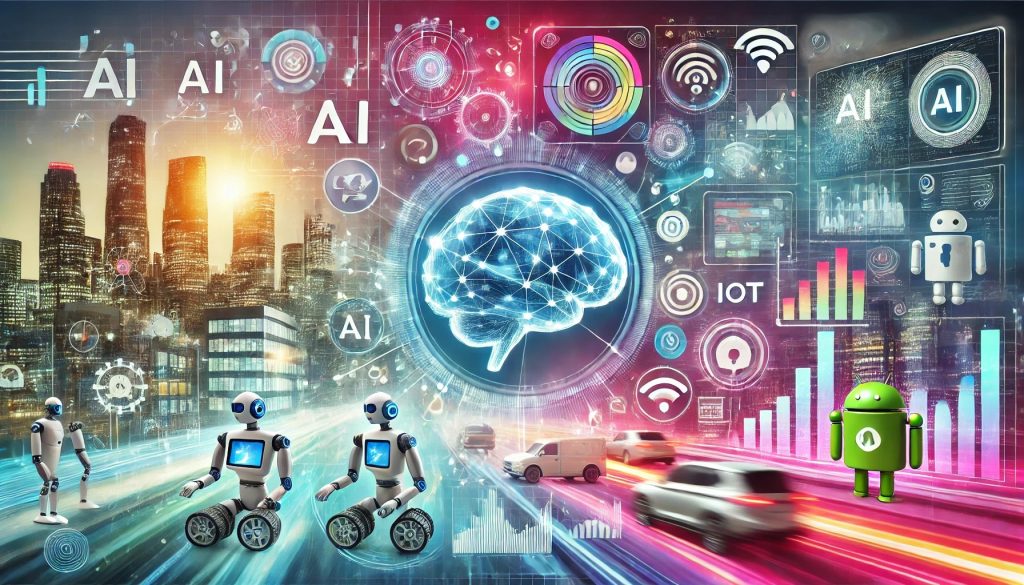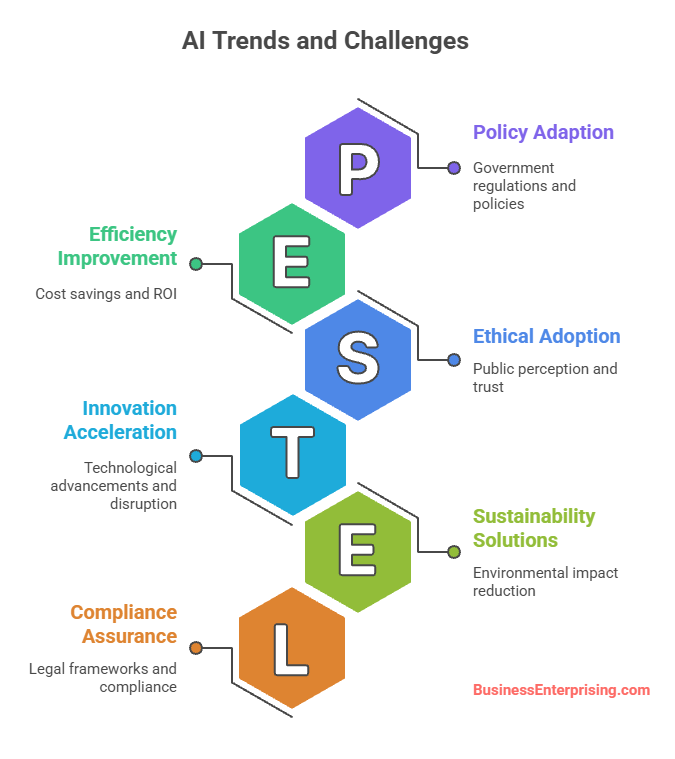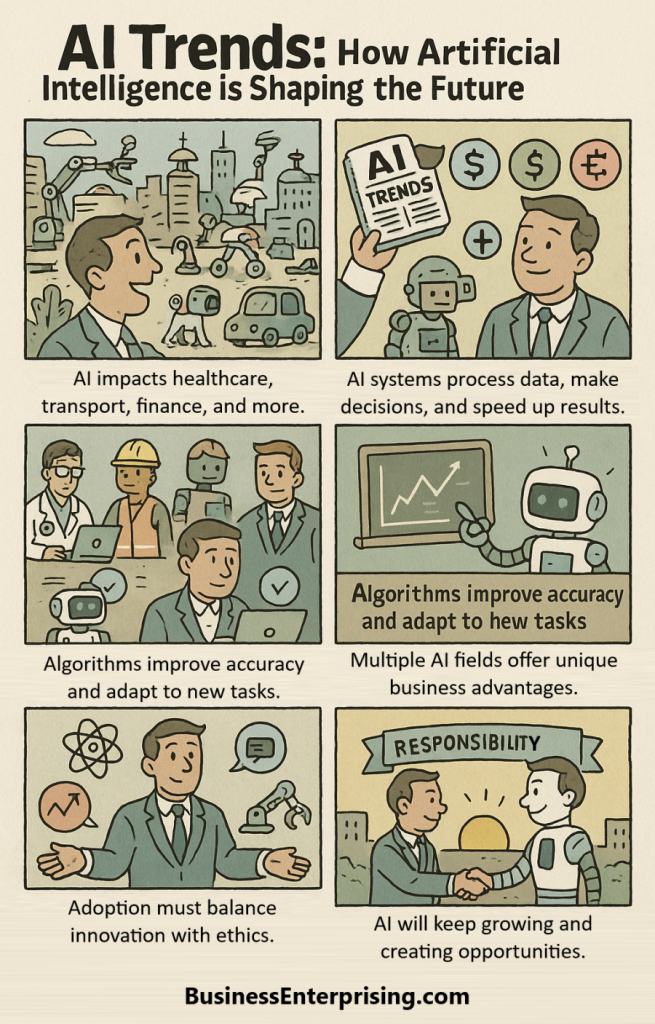
AI systems now handle tasks that once required significant human effort. Additionally, they process vast amounts of data to generate insights and guide decisions. This capability allows you to respond faster to changes and operate with greater accuracy. Furthermore, as algorithms improve, their ability to learn and adapt will continue to expand.
However, AI is not limited to one type of application. You will find it in automation, predictive analytics, and natural language processing. Each area offers different opportunities for improving operations and customer experiences. Therefore, staying aware of these developments can help you identify the most relevant uses for your needs.
Another important aspect is responsible adoption. As you consider new AI tools, think about transparency, fairness, and data privacy. Additionally, involving diverse perspectives in development and testing can help reduce potential issues before deployment. By taking a thoughtful approach, you can integrate AI in ways that support both your goals and the broader community.
AI continues to evolve, offering new possibilities for efficiency, innovation, and problem-solving. By following its progress and applying it strategically, you can make informed choices that deliver lasting value.
The Rise of Machine Learning and Deep Learning
Machine learning and deep learning have become key drivers in the growth of artificial intelligence. These technologies allow computers to learn from data, identify patterns, and make decisions with minimal human input. As you explore modern AI trends, you will notice that these methods are powering many new applications. Both machine learning and deep learning are shaping how industries approach problem solving and innovation.
Machine learning focuses on developing algorithms that improve through experience. Therefore, the more data these algorithms process, the better they perform. Deep learning builds on this by using neural networks with many layers to handle more complex tasks. For example, it can process images, speech, and text with high levels of accuracy. As a result, these methods are driving advances in healthcare, finance, retail, and other industries.
Additionally, researchers continue to create faster and more efficient algorithms. This progress allows systems to handle larger datasets and more complex problems. Businesses now use machine learning and deep learning to gain insights, predict outcomes, and automate decisions. Therefore, adopting these tools can help you improve efficiency and accuracy in your own operations.
Another important development is automated machine learning. This approach simplifies building and deploying models, making the technology accessible to more organizations. Furthermore, it allows companies without deep technical expertise to apply AI effectively. As you consider how AI can serve your goals, exploring these technologies can offer practical benefits. Machine learning and deep learning are no longer niche concepts. They are becoming integral to how you work, plan, and grow.
AI in Healthcare
AI is transforming how healthcare professionals diagnose, treat, and manage medical conditions. You can see its influence in hospitals, clinics, and research centers. These technologies process large amounts of medical data to provide faster and more accurate results. As AI trends continue to evolve, healthcare organizations are finding new ways to integrate these tools into daily operations.
Machine learning algorithms can analyze medical images to detect early signs of disease. Therefore, doctors can act sooner and improve patient outcomes. Additionally, AI assists in predicting patient risks by reviewing clinical histories and identifying potential complications. These capabilities help you make more informed decisions and allocate resources effectively.
Furthermore, AI supports drug discovery by processing complex datasets to identify promising treatments. This speeds up research and reduces development costs. In patient care, AI-powered systems personalize treatment plans by considering genetic, environmental, and lifestyle factors. As a result, you can offer care that better matches each patient’s needs.
Another growing use of AI is in hospital operations. AI can optimize scheduling, manage supply chains, and improve workflow efficiency. Therefore, staff can focus more on patient care instead of administrative tasks. Additionally, virtual health assistants now help answer patient questions, schedule appointments, and monitor chronic conditions. These tools give you more ways to provide continuous support beyond traditional visits.
AI in healthcare is no longer limited to research labs. It is becoming a practical tool you can apply to improve diagnosis, treatment, and patient experience. By understanding its applications, you can better prepare for the continued role AI will play in your field.
Natural Language Processing (NLP)
Natural Language Processing, or NLP, focuses on helping computers understand and respond to human language. You can see it in tools like chatbots, translation services, and voice assistants. These systems process text or speech, interpret meaning, and deliver a relevant response. As AI trends continue to grow, NLP is becoming an essential part of how businesses and individuals communicate with technology.
NLP works by combining linguistics and machine learning. Therefore, the system can analyze context, sentiment, and intent in conversations. Additionally, advanced models now generate text that reads naturally, making digital interactions more comfortable for users. You can apply NLP to customer support, content creation, and data analysis. These applications save time while improving communication quality.
Furthermore, businesses use NLP to gain insights from large volumes of unstructured text. For example, AI can review customer feedback and identify recurring themes or issues. This helps you respond more effectively to client needs and preferences. In global operations, real-time language translation breaks down communication barriers and supports collaboration across regions.
Another growing use of NLP is in personal productivity. AI-powered writing assistants can help you create clearer documents, organize ideas, and maintain consistent tone. Therefore, you can focus on the message rather than the mechanics of writing. Additionally, voice recognition systems now integrate with devices to streamline tasks like scheduling and information retrieval.
NLP continues to evolve and expand into new areas. By understanding its capabilities, you can apply it in ways that improve efficiency, strengthen relationships, and make technology work more naturally for you.
Ethical AI and Responsible AI Development
Ethical AI and responsible AI development focus on creating technology that benefits people while reducing potential harm. You have likely seen discussions about fairness, transparency, and accountability in AI systems. These principles guide developers to design tools that respect privacy, avoid bias, and operate within agreed standards. As AI trends evolve, the demand for responsible practices grows stronger.
Developers must consider how algorithms make decisions and who may be affected by them. Therefore, testing models for bias and accuracy is essential before deployment. Additionally, documenting how systems work allows you to explain outcomes to users and regulators. This transparency builds trust and encourages responsible adoption.
Furthermore, protecting data privacy plays a key role in responsible AI development. You should collect and store only the information needed for specific tasks. Limiting access and applying strong security measures helps reduce risks of misuse. In many industries, following ethical guidelines can also improve customer relationships.
Another priority is designing AI that supports human oversight. Systems should provide information in ways you can review and question. Therefore, humans remain in control of final decisions, especially in sensitive areas like healthcare or finance. Additionally, involving diverse teams in AI development can help identify potential issues earlier.
Responsible AI development benefits both businesses and society. By applying ethical principles, you can create technology that serves real needs while respecting human values. As more organizations adopt AI, prioritizing these practices will shape how the technology grows and how people trust its outcomes.
AI in Autonomous Systems
AI in autonomous systems focuses on creating machines that can operate with little or no human input. You may see this technology in self-driving cars, drones, and robotic delivery systems. These machines rely on AI to process data, make decisions, and act in real time. As AI trends progress, autonomous systems are becoming more reliable and capable of handling complex environments.
Autonomous systems use sensors, cameras, and machine learning algorithms to interpret their surroundings. Therefore, they can adjust to changing conditions and avoid potential hazards. Additionally, these systems can improve efficiency in industries like transportation, logistics, and manufacturing. You can benefit from faster deliveries, reduced human error, and lower operational costs.
Furthermore, advancements in AI allow autonomous systems to learn from experience. By analyzing previous actions and outcomes, they improve performance over time. This learning capability means they can adapt to new challenges without complete reprogramming. Therefore, businesses can apply them to a wider range of tasks with greater confidence.
Another important aspect is safety and reliability. Developers run extensive tests to confirm that autonomous systems respond correctly under various conditions. Additionally, integrating human oversight into critical decisions adds an extra layer of control. You can expect ongoing improvements as research focuses on making these systems safer and more adaptable.
AI in autonomous systems will continue to expand into new applications. By understanding their potential and limitations, you can make better choices about adopting this technology in your operations.
AI and IoT Integration
AI and IoT integration combines intelligent decision-making with connected devices to create more responsive and efficient systems. You may see this in smart homes, connected factories, and intelligent transportation networks. These systems collect real-time data from sensors and devices, process it with AI, and take immediate action. As AI trends continue to advance, the integration with IoT will bring more automation and accuracy to everyday operations.
Connected devices can track conditions, usage patterns, and performance metrics. Therefore, AI can analyze this data to predict issues and recommend adjustments. Additionally, this pairing improves energy efficiency, reduces downtime, and increases productivity. You can benefit from faster responses to changing conditions and better resource management.
Furthermore, AI enables IoT devices to learn from historical data. By recognizing patterns, these systems can anticipate future needs and optimize performance without constant human input. Therefore, you can rely on them for tasks that require quick and informed decision-making.
Security remains a significant focus for AI and IoT integration. Developers use AI to detect unusual activity and protect connected systems from potential threats. Additionally, this combination can improve safety in areas like healthcare monitoring and industrial equipment management. By applying these tools, you can improve reliability while maintaining control over critical processes.
AI and IoT integration will continue to expand in both consumer and business applications. By understanding its capabilities, you can find practical ways to incorporate these technologies into your own operations for measurable results.
AI for Environmental Sustainability
AI for environmental sustainability focuses on using technology to protect resources, reduce waste, and support long-term ecological balance. You can already see applications in energy, agriculture, and conservation efforts. These solutions use data analysis and automation to improve efficiency and reduce environmental impact. As AI trends evolve, more industries are adopting these methods to meet sustainability goals.
AI systems can monitor air and water quality using data from sensors. Therefore, they can identify pollution sources and recommend targeted actions. Additionally, in energy management, AI can balance supply and demand, integrate renewable sources, and reduce unnecessary consumption. You can use these capabilities to lower costs while reducing environmental harm.
Furthermore, AI supports precision agriculture by analyzing soil health, weather patterns, and crop conditions. This helps farmers apply resources only where needed. Therefore, water and fertilizer usage can decrease, and yields can improve without adding stress to the environment. In conservation, AI can track wildlife movements and detect illegal activities like poaching or deforestation.
Another growing area is waste reduction. AI can analyze production processes to identify inefficiencies and suggest improvements. Additionally, smart recycling systems use AI to sort materials more accurately, increasing recovery rates. These efforts contribute directly to a more sustainable economy.
AI for environmental sustainability offers practical solutions that benefit both the planet and your operations. By understanding and applying these tools, you can make measurable progress toward environmental goals while supporting long-term business success.
Conclusion
AI continues to expand its role across industries, offering new ways to improve efficiency, accuracy, and decision-making. You can see its influence in healthcare, manufacturing, energy, and countless other fields. These developments highlight the importance of understanding current applications and future possibilities. As AI trends advance, the technology will shape how you approach challenges and opportunities in your work.
Therefore, staying informed about progress in AI can help you make better strategic decisions. Additionally, exploring different use cases allows you to identify where AI can deliver measurable benefits. By focusing on practical applications, you can adopt tools that integrate seamlessly with your existing systems.
Furthermore, responsible development remains essential for building trust in AI. You can support this by selecting solutions that follow ethical guidelines and protect user data. This approach not only improves outcomes but also supports long-term adoption.
Another important factor is adaptability. AI technology will continue to evolve, and your ability to adjust will determine how effectively you use it. Therefore, keeping an open mind and encouraging ongoing learning within your organization can help you stay competitive. Additionally, testing and refining AI solutions will allow you to achieve better results over time.
AI is no longer limited to research labs or experimental projects. It has become a practical, everyday tool that supports better performance across sectors. By understanding how AI works and where it fits, you can make informed choices that align with your goals.


